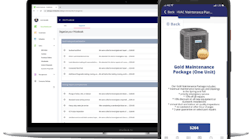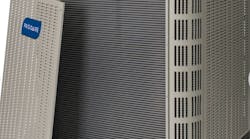Just a decade ago, a minority of installers would have predicted that in a few short years, the Internet would extend its reach into building automation. And since the Internet is the largest network infrastructure in the world, why not?
High-rise buildings have been wired with comprehensive direct digital control (DDC) systems for years, but what about small and midsized commercial properties whose owners could not justify a major investment in DDC? As broadband Internet access continues to proliferate in businesses throughout North America, it only makes sense that building automation providers would find a way to leverage their technologies to keep pace.
The Basics
Recently, a new generation of programmable communicating thermostats has emerged in the marketplace. These thermostats take advantage of ubiquitous Ethernet networks and the Internet to utilize the converged business network for HVAC control and do so at a fraction of the cost of traditional and complex proprietary energy-management systems.
On the outside, they appear in size and shape similar to any typical programmable thermostat. On the inside, they include not only the necessary HVAC functions but also the sophisticated Web server technology required to connect to the Internet. This new generation of Internet-powered thermostats stands alone yet offers all of the features integrators and commercial installers expect. They are compatible with most HVAC systems, offer single- and dual-stage heat and air conditioning support, flexible temperature scheduling and more. But the feature that truly sets them apart from all others is remote HVAC system monitoring and control.
Once installed and configured, users ? typically property owners or facilities managers ? are amazed by how easily they can control and monitor HVAC systems from their computers.
Using the Power of the Internet
Internet-powered thermostats use standard Web browser-based configuration and control over a secure Ethernet connection with no additional software to install. Typical browsers include Internet Explorer and Mozilla Firefox. Property owners, franchise owner/operators or facilities managers log in to a secure website from any computer, literally anywhere in the world (with Internet access), to set up and adjust HVAC system settings, timers and alarms or simply check in to monitor system functions. The graphical user interface (GUI) is secure, intuitive and as easy to use as most online banking screens. This remote management capability has numerous benefits, not the least of which is cost control.
Light commercial businesses continue to cope with ever-rising energy costs. Remote HVAC monitoring and control translate into significant cost savings, specifically:
-
Programmable Thermostat Maintenance — Monitoring, control and programmability over the Internet mean lower annual and seasonal service expenses associated with on-site visits for scheduled programming or setpoint adjustments. Without Internet connectivity, this yearly management often costs between $20 and $40 per thermostat.
-
Flexible Scheduling — Owners and property managers can customize the set-back schedules to meet specific needs with 365-day programming, not just 5-1-1 or 7-day programming as found on most commercial-grade programmable thermostats.
-
Abuse Management — These Web-enabled thermostats also include advanced button lockout features, which can be set remotely, that protect against inadvertent or malicious thermostat tampering by employees and others. The alternative option to mitigate abuse, a tamper-proof cover that prevents unauthorized changes, costs between $25 and $65 per thermostat.
-
Productivity — In light commercial applications, such as retail food outlets, you enhance the productivity of on-site personnel by eliminating daily local HVAC management tasks such as thermostat adjustments. Instead, thermostat management occurs automatically or from a central remote location.
The new generation of Internet-powered thermostats also comes equipped with automatic alarm notification features, which can further reduce energy costs by alerting owners and facilities managers of potential problems with the HVAC system. Again, through the browser GUI, users can easily set system parameters for each thermostat, and as the thermostat detects an over- or under-temperature condition, it will immediately send a text message alert to a preset cell phone number or e-mail address. Some thermostats are also capable of sensing and controlling humidity, which is crucial in certain commercial — and geographic — applications.
Proliphix, which was the first company to introduce Web-enabled thermostat technology, will soon offer a thermostat with advanced thermal management capabilities. This product will not only manage your HVAC system remotely but also feature two external thermal sensors, which will enable users to set high and low temperature limits for each sensor. If the temperature at any sensor exceeds or falls below these limits, an alarm triggers a log and dispatches an e-mail or text message alarm. This is ideal for restaurant and convenience store applications, for example, because you can remotely monitor internal freezer, refrigerator and cooler temperatures.
E-mail and text message notification will ensure steady system operation and almost instantly generate savings in repair and equipment replacement costs. Savings can be realized through:
- Business Continuity — In situations where a property is unattended or unoccupied overnight, it is possible to notify the property owner, facility manager and HVAC service contractor immediately if the thermostat detects an alarm condition and take immediate corrective action, thereby minimizing business downtime and ensuring business continuity. Service fees for HVAC health monitoring for proprietary, more complex energy management products may cost between $24 to $120 per rooftop unit per year ($2 to $10 per month).
- Equipment Insurance — As alarm recipients receive e-mail or text message notifications and take immediate action, out-of-temperature conditions may indicate imminent failure of related equipment. A rooftop unit which experiences a “freeze-up” may continue to cycle the compressor to maintain the zone temperature. If this compressor cycling continues without notice for periods exceeding 72 hours, damage to the compressor may be irreversible and may ultimately require replacement. Costs for compressor replacement for the average 5-ton HVAC rooftop unit may cost between $700 and $1,000 installed.
- Filter Change Reminder — Some Internet-powered thermostats offer a fan run time counter and will send a text message to remind the owner or facility manager to change rooftop unit air filters. This event is HVAC cycle-related and needs attention only after the system has run for the duration specified by the facilities manager. You therefore schedule preventative maintenance “as needed” and not as the calendar dictates.
Businesses owners across the United States have already realized cost savings in both energy consumption and equipment repair and replacement as a direct result of remote management and alarm messaging through the power of the Internet.
Making the Shift
Although this new technology is not appropriate for every application, it is ideal for multiunit residential and light commercial applications. Small-box franchisees, in particular, are thrilled by the early but immediate results they have experienced with Internet thermostats. These early adopters recognized the potential benefits of this technology and that they could quickly recoup their investment cost in reduced energy consumption and maintenance costs.
And the shift is not a painful one. The technology is easily integrated into most settings, and installers typically require very little guidance — a building can be up and running in just hours. Compared with the time and material investment of more complex energy management systems, Internet-powered thermostats can be up and running quickly and without equipment provider personnel.
It is clear that Internet technology has arrived as a viable option for residential and light commercial HVAC control, and with the relatively small investment compared with the tremendous potential benefits, it has arrived none too soon.
Scott Hewett is the director of channel sales for Proliphix Inc. of Westford, MA. Proliphix manufactures a range of Web-enabled thermostats for residential and light commercial applications. Contact Scott at [email protected] or visit www.proliphix.com.





